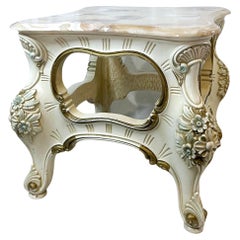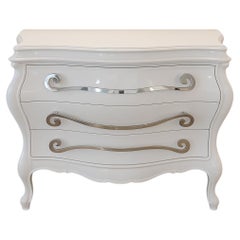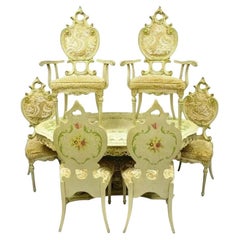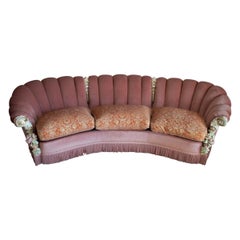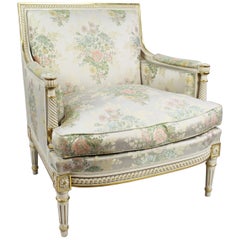Silik Italian
Italian Hand Carved and Painted Silik Furniture End Table
Located in Waxahachie, TX
Hand carved and painted.
Vintage Italian Silik Furniture end table.
Carved, painted flowers
Category
Mid-20th Century Italian Rococo Revival End Tables
Materials
Wood
$312 Sale Price
75% Off
H 23 in W 23 in D 23 in
Classic white lacquered dresser - Creations by Silik Berto
Located in Alcamo, IT
Berto – Creazioni by Silik
An icon of contemporary baroque. Berto is a three-drawer dresser that
Category
2010s Italian Commodes and Chests of Drawers
Materials
Wood
Silik Style Italian Baroque Rococo Dining Room Set by John Turano & Sons - 7 Pcs
By John Turano & Sons
Located in Philadelphia, PA
Silik Style Italian Baroque Rococo Dining Room Set by John Turano & Sons. Listing includes (2) 15
Category
Mid-20th Century Unknown Baroque Dining Room Sets
Materials
Wood
$6,800 / set
H 48 in W 28.5 in D 22 in
Venetian Baroque Style Fancy Velvet Sofa and Two Armchairs by Silik, 1960s
Located in Puglia, Puglia
This sofa with two armchairs was created by the artisans of the famous Cantù company, Silik, in the
Category
Vintage 1960s Italian Baroque Sofas
Materials
Velvet, Beech
$5,296 / set
H 29.53 in W 102.37 in D 47.25 in
Recent Sales
Italian Painted and Gilt Carved Wood Silik Upholstered Armchair
Located in Worcester, Worcestershire
Period
Vintage, late 20th century,
Origin
Made by Silik, made in Italy
Composition
Category
20th Century Armchairs
Materials
Other
People Also Browsed
Austrian Bentwood Queen Sized Bed by Jacob & Josef Kohn, 1900
Located in Miami, FL
Designed by J & J Kohn, this mahogany stained bentwood bed features curved head and footboards swelling with decorative scroll form tendrils.
J & J Kohn, No. 876, 1900 Catalog.
He...
Category
Early 20th Century Austrian Vienna Secession Beds and Bed Frames
Materials
Bentwood
$5,000 Sale Price
20% Off
H 55.91 in W 57.49 in D 76.78 in
Art Nouveau Guimard Chandelier
By Hector Guimard
Located in Rebais, FR
Art Nouveau Guimard chandelier with nickel finish.
Category
21st Century and Contemporary French Art Nouveau Chandeliers and Pendants
Materials
Bronze
Rosso Wall Mirror
By Specchi Veneziani
Located in Milan, IT
Venetian mirror made in the strictest Murano tradition. Assembled with crystal/gold and red elements handmade in the Murano furnaces. Wooden frame with a natural finish.
Category
2010s Italian Renaissance Wall Mirrors
Materials
Glass
Serenity Organic Modern Contemporary Wall Sconce, Wall Light, White Plaster
By Hannah Woodhouse
Located in London, GB
Handmade “Serenity” organic modern wall light/wall sconce, in silky smooth white plaster, created by artist Hannah Woodhouse in her London studio. Contemporary organic modern design ...
Category
21st Century and Contemporary British Organic Modern Wall Lights and Sco...
Materials
Plaster
$812 / item
H 11.8 in Dm 4.7 in
Hollywood Regency Bar and Stools in the Style of Willy Rizzo Brass Suede
By Willy Rizzo
Located in Waalwijk, NL
Cocktail bar with bar stools, brass, suede, glass, smoked mirrored glass, chrome-plated steel, wood, plastic, Italy, 1970s
Hollywood Regency cocktail bar in the style of Willy Rizz...
Category
Vintage 1970s Italian Hollywood Regency Dry Bars
Materials
Brass, Steel, Chrome
$15,400 / set
H 77.96 in W 55.91 in D 6.3 in
French Empire Style 19th Century Napoleon III Giltwood Mirror with Sphinxes
Located in Los Angeles, CA
A very fine French Empire style 19th century Napoleon III giltwood and gesso carved figural mirror frame, flanked by a pair of sitting winged sphinxes, with carved scrolls, garlands ...
Category
Antique 19th Century French Empire Revival Mantel Mirrors and Fireplace ...
Materials
Gesso, Mirror, Wood
$36,000 Sale Price
20% Off
H 66 in W 52 in D 5.25 in
Floral Swag - A French Classic Louis XV Style Caned Bed by La Maison London
By La Maison London
Located in London, Park Royal
The Floral Swag Bed is a beautifully handcrafted statement piece in the classic French Louis XV Corbeille style. Featuring its signature rounded corners, the bed’s curved headboard a...
Category
2010s British Louis XV Beds and Bed Frames
Materials
Wood
$23,425
H 61.42 in W 83.47 in D 67.72 in
Mahogany Bookcase, First Half of the 19th Century
Located in Greding, DE
Two-doored mahogany bookcase with a straight base and a slightly protruding top, decorated with a carved female head.
Category
Antique 19th Century European Biedermeier Bookcases
Materials
Mahogany
Antique Quartersawn Oak French Renaissance Revival Dining Table Library Desk
Located in Dayton, OH
Antique 19th Century Figural French Renaissance Revival / Elizabethan style Dining or Library Table. A rectangular form made from oak with a quartersawn top. Features a thick gadroon...
Category
Antique 1880s Renaissance Revival Dining Room Tables
Materials
Oak
$2,450 Sale Price
47% Off
H 30 in W 34.5 in D 50 in
LOVELY DOUBLE SiZED CIRCA 1920 CHINESE CHINOISERIE BEDSTEAD FRAME PART SUITE
Located in West Sussex, Pulborough
Royal House Antiques
Royal House Antiques is delighted to offer for sale this stunning Circa 1920, super rare and collectable, bleached Walnut, Chinese Chinoiserie bedstead frame wi...
Category
Vintage 1920s Chinese Chinoiserie Beds and Bed Frames
Materials
Walnut
$2,937 Sale Price
20% Off
H 43.71 in W 53.94 in D 77.17 in
Dooq Mid-Century Modern Pouf Ottoman with Dijon Velvet, Silk Fringes La Folie
By DOOQ
Located in Lisbon, PT
With voluptuous curves and perfect poise, the Mid-Century Modern inspired La Folie Pouf Ottoman exalts passion and fantasy as if you were in a burlesque show at Moulin Rouge. Let you...
Category
21st Century and Contemporary Portuguese Mid-Century Modern Ottomans and...
Materials
Silk, Velvet
$2,093 / item
H 17.33 in Dm 25.2 in
Murano Art Glass and Brass Pink Color Wall Light and Sconces, 2020
Located in Roma, Lazio
This charming wall lamp is entirely handmade in Murano. Each single leaf is handcrafted in high quality Murano blown glass; that's why each leaf is slightly different from the other....
Category
2010s Italian Mid-Century Modern Wall Lights and Sconces
Materials
Brass
$1,762 / item
H 32.29 in W 18.12 in D 9.06 in
19th Century Italian Neoclassical Oil on Leather Three Panel Room Divider
Located in Forney, TX
A lovely 19th century Italian neoclassical oil on leather folding screen room divider.
Born in Italy, circa 1860, featuring patinated brass hinged three panel wooden frame wrappe...
Category
Antique 19th Century Italian Neoclassical Revival Screens and Room Dividers
Materials
Leather, Wood, Paint
$3,500
H 73 in W 66.5 in D 1 in
8 Vintage Charles II Carolean Style Carved Oak Dining Room Chairs
Located in Dayton, OH
An impressive set of 8 Charles II or Carolean style dining chairs made in Okinawa Japan, circa 1970s. Hand crafted from oak with an oval upholstered back centered between turned stil...
Category
Vintage 1970s Charles II Dining Room Chairs
Materials
Upholstery, Oak
$1,645 Sale Price / set
30% Off
H 43.5 in W 22 in D 23 in
19th Century Italian Pinewood Bookcase - Large Antique Library Cabinet
Located in West Palm Beach, FL
A large antique Italian library cabinet made of hand crafted Pinewood, in good condition. This stunning bookcase library from Tuscany has a grey antique patina with light grey painte...
Category
Antique Mid-19th Century Italian Bookcases
Materials
Metal, Bronze
$29,700
H 108.5 in W 109 in D 19.5 in
Pair of 1960's Hollywood Regency Duquette Style Gold Leaf & Eglomise Cabinets
By Lane Furniture, Tony Duquette
Located in Hanover, MA
BG WINTER SALE
Amazing and rare pair of vintage early 1960's cabinets from from an outrageously over-the-top period Hollywood Regency decorated home outside of Boston; think Zsa Zsa...
Category
Vintage 1960s American Hollywood Regency Cabinets
Materials
Art Glass, Giltwood
$7,500 Sale Price / set
50% Off
H 30 in W 36 in D 16 in
Get Updated with New Arrivals
Save "Silik Italian", and we’ll notify you when there are new listings in this category.
More Ways To Browse
Marriage Dowry Chest
Martaban Dragon Jar
Martaban Dragon
Martin Benito
Maru Obi
Mashiko Yaki
Mashrabiya Furniture
Masque De Femme
Mastercraft China
Mastercraft King Headboard
Match Safe Vesta
Matching Bachelor Chests
Matching Display Cabinets
Matchstick Holder Antique
Matte Green Pottery
Matteo Thun Teapot
Maurice Bouval Art Nouveau
Maurizio Mariani
